Halewood, located 8 miles south-east of Liverpool was originally part of Hale and it is difficult to discover when they separated but by the 15th Century, Halewood was definitely a separate township within the West Derby Hundred. The township of Halewood lies between the old course of Ditton Brook in the north and Rams Brook in the south. Disputes over the manor lands of Halewood between the Ireland and Holland families began in the 13th Century and were to be ongoing for some time. The Ireland family had Hale, most of Halebank and part of North End, while the Holland family who were the superior lords, controlled most of North End and a portion of Halebank. However, the Hollands were based at a Hall in Halebank, while the Irelands’ main residence was the ‘Hutt’ within Halewood. This confusing state of affairs continued for centuries.
By 1628 the manor of Halewood was part of the dower of Charlotte Countess of Derby. During 19th Century, Halewood was still divided between two manors, the Ireland portion held by the Ireland-Blackburne’s, and the Holland portion by the Earls of Derby.
In general, the Halewood township changed little over the centuries. Being made up of scattered farms, it was therefore predominantly agricultural but, by the mid-19th Century, changes did appear with the introduction of the railways and industrialisation. The township was crossed by two main railway lines: the upper line was owned by the Cheshire Lines Railway which ran between Hunts Cross station and Halewood station in Bailey’s Lane and included north-south branch lines which together formed an area in between known as the Halewood triangle. A more southerly track was owned by the London and North Western Railway which carried the Garston-Warrington line with stations at Halebank and Ditton Junction.

The North End of the township retained its rural roots despite the railway; while the area around Lane Ends evolved into Halewood Village with the building in 1839 of St. Nicholas’ as a Chapel of Ease to the churches of Childwall and Huyton. The building was greatly enlarged in 1847, becoming a rectory and thereafter a true parish church in 1868. The tower and bells were added around 1883.
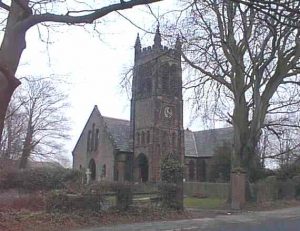
The village school was built next door to the church in 1876. For the non-conformists in the area, a Wesleyan Chapel was built at Halebank in 1861.
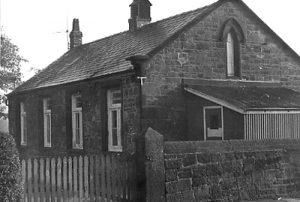
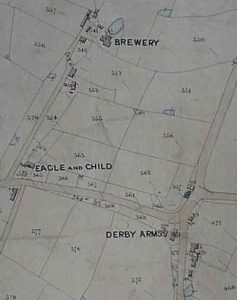
Landmarks, in the form of the Eagle and Child and Derby Arms in Church Road featured prominently on the historic Tithe Map of 1843, along with the now defunct brewery .
One of the oldest highways in the township is Lower Road (formerly Lower Lane) where one can still see many fine old houses and farms including: Ireland’s Farm; The Hayes, the main house of which has a builder’s stone dated 1867; Wellcroft Cottages; Brook House; Harefield/Ashton Hey and many others.
The southern portion of the township, Halebank, close to the Mersey, became the industrial sector due to its close ties with nearby Ditton and Widnes; so much so, that the ‘Ireland’ portion of Halebank became part of the Widnes Corporation in 1920. Land in Halewood’s North End and part of Halebank held by the 17th Earl of Derby, was sold to Liverpool Corporation in 1930 and subsequent plans were made for housing development in the township to alleviate the problem of overcrowding in central Liverpool.
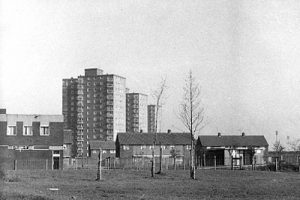
From mid-1950s onwards, large housing estates including tower blocks were built to cater for the surge in the population; an increase of ten-fold by 1970s.
The area of land occupied by the Old Hutt in the south-west of the township must originally have been a holding of some note. The remains of the Old Hutt which stood until recently, consisted of a three storey gatehouse, within a quadrangular moat leading to what would have been the main house.
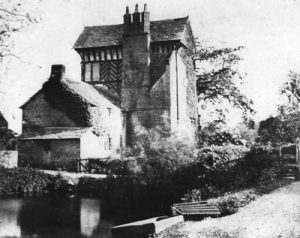
An archway, the entrance way to the main house, also part of the remains, was considered to have been of early 14th Century construction. By the 19th Century, the Old Hutt was in use as a farm but by the middle of the 20th Century, the land around it was required for other purposes.
The increase in population brought initial unemployment to the area but in 1960, the Ford Motor Company sought a site for car production in Britain and Halewood was put forward by the Government as an option. Halewood was chosen and the plant was completed by 1963. Production began with the Ford Anglia and the very first car off the production line was later preserved at Liverpool Museum. Halewood’s Ford factory brought prosperity to the area but in the building of the plant, two ancient moated sites were destroyed: the Old Hutt, and Wrights Moat.
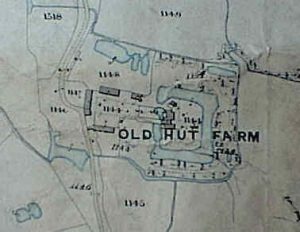
In 1974, Halewood became part of the newly created Metropolitan Borough of Knowsley. Since that time, great improvements have been made in the scope of leisure activities for the local community. Bridgefield on Cartbridge Lane, once the site of a large house with its own lodge was demolished and replaced by Bridgefield Forum, the sports and leisure complex. Bridgefield Forum has now been demolished but replaced by more modern leisure facilities at Halewood Leisure Centre which opened in Bailey’s Lane in 2002.
Following the discontinued usage of the old Cheshire Lines Railway and the removal of track from the two upper sides of the Halewood Triangle rail junction, land was purchased from British Rail in 1982 for the development of a park. The culmination of the project was the opening by Lord Winstanley in 1986 of the Halewood Triangle Country Park, offering nature conservation combined with recreational facilities.
Everton F.C.’s new training complex facilitating both the mens’ and womens’ first team and a youth academy opened in October 2007 at the 55 acre site of Finch Farm, off Higher Road and Finch Lane. The building’s official name is USM Finch Farm.
Halewood’s original branch library building on Leather’s Lane which opened in 1967 has now been demolished but was replaced by a new build. The new library is housed in the multi-purpose Halewood Centre off Roseheath Drive, close to the Halewood Shopping Centre and bus station in Leather’s Lane which opened in 2012.
A major landmark to disappear in recent times was The Derby Arms public house on Church Road, the site now being occupied by Derby Court, private residential flats built in 2015.
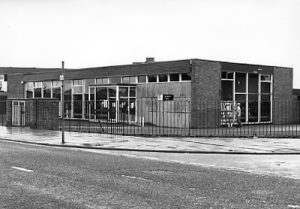
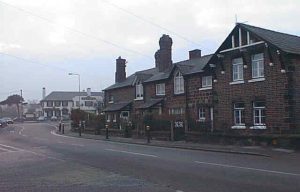
Following an earlier assessment review by Inspectors, it was announced in July 2020, that Yew Tree Primary Academy, Halewood, had retained the prestigious Inclusion Quality Mark Award of ‘Flagship School’ status for the third year running.
The Coronavirus pandemic in 2020 dominated the news for the whole year. A timeline of the events that occurred can be consulted here: COVID-19 National and Local timeline 2020
Planning applications were approved in February 2021 to build 1,300 new homes in the east of Halewood on the site of the former RSPCA Centre and in the fields off Bailey’s Lane and Greensbridge Lane. Construction is likely to begin in the summer-autumn 2021.
As the Coronavirus pandemic continued in 2021 with new variants appearing, a further timeline shows the changing situation throughout the year: COVID-19 National and Local timeline 2021
As Knowsley is the Liverpool City Region’s Borough of Culture in 2022, a number of illuminated after-dark artworks are scheduled at various townships within the borough. During the weekend of 21st-23rd January at Court Farm Woods, the illuminated artwork ‘The Magic Wood’ created by the outdoor art company Walk the Plank was presented. The illuminated trail was a great success, viewed by over 2,000 people.
New CCTV cameras installed in the township during March in a bid to tackle crime and anti-social behaviour.
In August, national charity The Reader launched a weekly reading group at Halewood Library and artist James Brunt completed his large-scale public land art installation titled The Knowsley Mandala at the Halewood Triangle.
Announced in September 2022, to tie in with the new housing developments in the east of the township, school places at Plantation Primary School and Nursery are to be increased.
To provide support to Knowsley Borough residents during the winter months, all library buildings in the borough are to become Warm Hubs from 1st November 2022 till the end of March 2023.
The success of the UK’s vaccination programme meant that coronavirus restrictions were eased in 2022. A summary of COVID-19 information for the year can be found here: COVID-19 National and Local timeline 2022
Knowsley Council recently submitted three bids for funding under Round 2 of the Government’s Levelling Up Fund one for each of the townships of Halewood, Huyton and Prescot. The bid for Halewood township, was to accelerate the expansion and improvement of the local centre of the district and to improve greenspace and leisure facilities throughout the area. A government announcement made on 18th January 2023 stated that only the Halewood bid out of the three proposals had been successful. The announcement confirmed an allocation of £15.3m for improvements in the township.
The UK Government’s Emergency Alerts System is now live and will be used to warn people when lives are in danger, initially to warn of severe weather-related incidents including flooding and provide instructions how to respond to an alert. To check the system, a test took place at 3pm on Sunday 23rd April whereby most people received an official text message on their mobile phones.
The latest COVID-19 information can be found here: COVID-19 National and Local timeline 2023 (to end of May 2023)
Following the ongoing house-building programme and with it an increase in the local population, a new Turkish and Mediterranean restaurant Casa Rima opened on Bailey’s Lane at the end of September.
